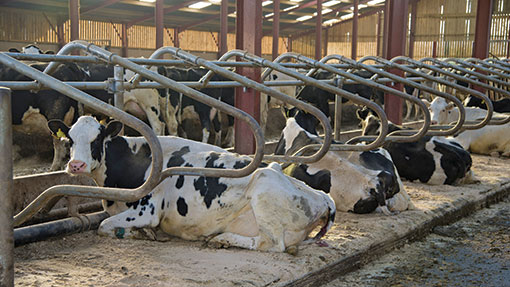Top tips on investing in new dairy housing

With so many options, what should farmers look at when buying new housing for cows?
A renewed confidence in the dairy industry fueled by stronger prices is encouraging milk producers to consider the economics of new livestock housing, after years of under-investment.
Cubicle size and design, feed barriers and passages are crucial to cow welfare and subsequent productivity so getting the specifications right must be a priority.
But the very first consideration with new housing should be the location, says Tim McKendrick, principal consultant at The Dairy Group.
See also Pros and cons of beef cattle housing systems
“As they say on the TV programme, location, location, location. Give lots of thought on where to site the new housing in relation to how it fits in with the rest of the farm, how it will fit in with future facilities such as new milking facilities, slurry storage and additional housing?” he says.
Other important points are cow flow, utilising natural gradients on a site, ventilation and how a building will be viewed by planners.
“Try to match group size with the throughput of the existing or proposed parlour,” says Mr McKendrick. Ideally, cow groups should be milked within an hour and returned to housing.
Mr McKendrick recommends visiting other dairy units to investigate the options for the internal layout of cubicles, as this varies greatly.
“Just because a layout works for one farm does not mean it is ideal for another,” he says. “Work through the daily routines of milking, scraping, bedding up, feeding and how this works with the layouts being considered. Identify any bottlenecks and whether they can be overcome.”
Well-ventilated housing will boost cow health and productivity.
In general terms, for exit ventilation to be adequate there should be a 5cm ridge opening for every 3m of building width. Inlet ventilation should be spread evenly over both sides of the building and this should be a minimum of twice the exit ventilation, but four times is ideal.
Housing checklist
- Location, location, location – ensure you choose the right site
- Adequate ventilation – aim for 5cm ridge opening for every 3m of building width. Inlet ventilation should be at least twice the exit ventilation
- Roof pitch can affect ventilation
- Avoid extreme flooring types – brush finish, hexagonal patterns or grooves can work
- Bedding options include sand, sawdust, straw and mattresses
- Brisket control – no higher than 100mm
- Three rows of cubicles to one feed fence can put pressure on feeding access
- Position water for good access after milking with 10cm trough space a cow
Adequate inlet ventilation can be achieved in a number of ways, including space boards, Yorkshire boarding, vented steel cladding and adjustable curtain sides.
Roof pitch has a bearing on how well a building ventilates and can vary from 10-22.5deg.
Steeper roof pitches raise the ridge height and can create planning issues, Mr McKendrick warns. “A shallower roof pitch with the use of slotted or raised roof sheets can ensure a building ventilates well, even at 10deg,” he says.
He cautions farmers to be wary of slotted roofs if they are considering installing solar panels. “Rain ingress can be a real problem running off the panels and fixing channels.”
When it comes to flooring types, he suggests avoiding extreme surfaces. “A light tamp, brush finish are OK,” he says.
Hexagonal patterns made by a roller work well, too, if they are done well, as can float finishes with grooves running across and down the passage.
Bedding needs careful consideration, based on cost, slurry storage and handling equipment.
Sand is an excellent bedding material but it is not for everyone, says Mr McKendrick. “Sawdust and straw are still common favourites and can work well when kept clean and adequate amounts are used.”
If the option of mattresses is being explored, he recommends that farmers do their homework. “Ask lots of questions about the materials, longevity and warranty and go and look at installations.
“The same goes for cubicle divisions, there are so many different varieties available now and many do the job in a slightly different way.”
See also More on the Livestock Event
The cow needs to be able to get into the cubicle space, stand up comfortably with four hooves on the bed, but be positioned where slurry and urine lands in the passageway.
Similarly, when a cow is lying down, there should be a brisket control that allows her to lie comfortably, but with waste being deposited in the passageway.
“The brisket control should not be too high, a maximum of 150mm, but preferably not above 100mm, so as not to inhibit a cow’s lying and rising positions when she lunges and steps forward as she rises,” says Mr McKendrick.
Feeding access is better in a two-row cubicle house and can give between 700-800mm of feed space a cow.
Three rows of cubicles to one feed fence is more likely to put pressure on feeding access and can result in as little as 450mm of feed space a cow.
Water should be positioned to enable good access after milking with 10cm of linear trough space a cow.
“Tipping or fast-emptying water troughs are very helpful in keeping troughs clean, but if water pressure is good, the troughs don’t have to be large capacity as daily tipping of large troughs adds to the volume going into the slurry store,” says Mr McKendrick.
